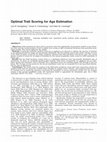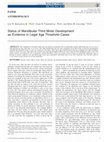Papers by Lyle Konigsberg

Elsevier eBooks, 2018
In forensic anthropology the size of “organs” (bones) from the skeletal system is often used to e... more In forensic anthropology the size of “organs” (bones) from the skeletal system is often used to estimate an individual's stature via linear regression of stature onto one or more bones. This type of analysis is the reverse of how one usually studies size and shape in biology, where organ sizes are viewed as being dependent on body size. We show that the multivariate regression of bone sizes onto body size (stature) provides a very general framework for both the estimation of stature and for the presentation of evidence on a putative identification. We further show that using an informative prior for stature from the reference sample is completely equivalent to performing the traditional regression of stature onto long bones, that using a uniform prior for stature gives the maximum likelihood estimator for stature, and that using an informative prior stature distribution from a relevant population provides a “population specific” method.
Cambridge University Press eBooks, Jan 18, 2017

American Journal of Physical Anthropology, 2004
This study examines quantification techniques applicable to human skeletal remains, and in partic... more This study examines quantification techniques applicable to human skeletal remains, and in particular the Lincoln index (LI), the minimum number of individuals (MNI), and what we refer to as the most likely number of individuals (MLNI), which is a modification of the LI by Chapman ([1951] Univ. Calif. Publ. Stat. 1:131–159). As part of the study, a test of pair‐matching between commingled homologous elements, e.g., right and left femora, was performed based on gross morphology. The results show that pair‐matching can be accurately performed, and that the MLNI is a useful technique for dealing with well‐preserved commingled remains recovered from archaeological excavations and/or forensic investigations. Our results show that it is potentially misleading to draw population conclusions based on the MNI, except in instances where recovery is near 100%. The MLNI was found to be the best method to compensate for the potential underestimates of the MNI and potential bias in the original L...

Journey of a committed paleodemographer, 2021
Bocquet-Appel's most highly cited work was his article with Claude Masset published in 1982 in th... more Bocquet-Appel's most highly cited work was his article with Claude Masset published in 1982 in the Journal of Human Evolution: "Farewell to paleodemography." Indeed, this article has been cited over twice as much as Bocquet-Appel's second most cited article ("When the world's population took off") from the journal Science. While on the surface Bocquet-Appel and Masset's "Farewell" might be taken as a literal adieu, the article functioned as a clarion call for a paradigm shift in paleodemography. The article pointed out a problem later to be known as "age mimicry," it questioned the statistical basis for age estimation in paleodemography, and it introduced new demographic estimators that were related to life table parameters while being relatively resistant to biases. Had Bocquet-Appel simply stopped at this point, his contributions to paleodemography would have been substantial. Instead, he continued to publish and push for improvements in paleodemographic methods. While others toiled on maximum likelihood methods, Bocquet-Appel was at the vanguard of those developing Bayesian methods in paleodemography. Although these Bayesian methods were crystalized by others, it is questionable whether they would have done so without Bocquet-Appel's work in and following his "Farewell to paleodemography" with Masset.
Human Biology, 2018
While discriminant function analysis is an inherently Bayesian method, researchers attempting to ... more While discriminant function analysis is an inherently Bayesian method, researchers attempting to estimate ancestry in human skeletal samples often follow discriminant function analysis with the calculation of frequentist-based typicalities for assigning group membership. Such an approach is problematic in that it fails to account for admixture and for variation in why individuals may be classified as outliers, or non-members of particular groups. This paper presents an argument and methodology for employing a fully Bayesian approach in discriminant function analysis applied to cases of ancestry estimation. The approach requires adding the calculation, or estimation, of predictive distributions as the final step in ancestry-focused discriminant analyses.

American Journal of Physical Anthropology, 2015
Objectives: Little attention has been paid to questions about the applicability of parametric mod... more Objectives: Little attention has been paid to questions about the applicability of parametric models to age estimation data and the related problem of how to adjust trait scoring in light of potential deviations from particular parametric models. This article addresses this deficit. Methods: A Lagrange multiplier goodness-of-fit test is applied to two datasets to address the question of whether or not attainment ages for stages are log-normally distributed. The first dataset used in this article consists of scores of the Todd ten-phase system for the pubic symphysis obtained from 938 individuals with known ages. The second dataset consists of scores for 15 stages of formation for the second mandibular molar scored in 2,304 individuals of known age. Results: For the Todd ten-phase system there is a significant departure from log-normally distributed ages of attainment. To obtain an acceptable goodness-of-fit statistic, Todd scores consequently are collapsed into an eightphase system that maintains scores I through VII as individual scores but combines phases VIII through X into one phase. The 15-stage scoring system for the second mandibular molar has an acceptable fit to the log-normal distribution for ages of attainment. Conclusions: The results from the analysis of the Todd pubic symphysis scores show that researchers should use goodness-of-fit tests for parametric models before deciding to collapse scores. Further, such goodness-of-fit tests are an essential tool in answering questions concerning the suitability of various parametric models. For the 15-stage scoring of the second mandibular molar, the log-normal model is appropriate for attainment ages.
Research Methods in Human Skeletal Biology, 2013
American Journal of Physical Anthropology, 2003
American Journal of Physical Anthropology, 2019
In their article, Klales, Ousley, and Vollner (2012) codify Phenice's (1969) three sexually dimor... more In their article, Klales, Ousley, and Vollner (2012) codify Phenice's (1969) three sexually dimorphic characters of the pubic symphysis into five-point ordinal scores. Although we see this as a valuable contribution, we have considerable issues with the statistical methods used in Klales et al. (2012). Although seven years have passed since their publication in this journal, we feel that a comment is necessary because their statistical methods have continued to be used (Kenyhercz, Klales,

American Journal of Physical Anthropology, 2013
In this article, we both contend and illustrate that biological anthropologists, particularly in ... more In this article, we both contend and illustrate that biological anthropologists, particularly in the Americas, often think like Bayesians but act like frequentists when it comes to analyzing a wide variety of data. In other words, while our research goals and perspectives are rooted in probabilistic thinking and rest on prior knowledge, we often proceed to use statistical hypothesis tests and confidence interval methods unrelated (or tenuously related) to the research questions of interest. We advocate for applying Bayesian analyses to a number of different bioanthropological questions, especially since many of the programming and computational challenges to doing so have been overcome in the past two decades. To facilitate such applications, this article explains Bayesian principles and concepts, and provides concrete examples of Bayesian computer simulations and statistics that address questions relevant to biological anthropology, focusing particularly on bioarchaeology and forensic anthropology. It also simultaneously reviews the use of Bayesian methods and inference within the discipline to date. This article is intended to act as primer to Bayesian methods and inference in biological anthropology, explaining the relationships of various methods to likelihoods or probabilities and to classical statistical models. Our contention is not that traditional frequentist statistics should be rejected outright, but that there are many situations where biological anthropology is better served by taking a Bayesian approach. To this end it is hoped that the examples provided in this article will assist researchers in choosing from among the broad array of statistical methods currently available.

Journal of forensic sciences, Jan 8, 2018
The completion of the third molar roots has played an important role in ascertaining whether indi... more The completion of the third molar roots has played an important role in ascertaining whether individuals may be at or over a legal threshold of age, often taken as 18 years. This study demonstrates that root apex completion in the third molar is relatively uninformative regarding the threshold of age 18 years in a sample of 1184 males, where mean age-of-attainment of root apex completion for third mandibular molars is about 19.4 years. This paper also considers the legal age threshold problem for cases where the third mandibular molar is not completely formed, and outlines the use of parametric models and Bayes' factors to evaluate dental evidence in statistically appropriate ways. It attempts to resolve confusion over age-within-stage versus age-of-attainment, likelihood ratios versus other diagnostic tests, and prior odds for a case versus the prior density for an age distribution.

The use of multivariate quantitative trait information to address questions of population relatio... more The use of multivariate quantitative trait information to address questions of population relationships and evolutionary issues has a long-standing history in human anthropometry. Previous analyses have usually rested on a number of explicit or implicit assumptions that allow phenotypic information to be used as a proxy for quantitative genetic information. One (usually implicit) assumption is that the additive genetic variance-covariance matrix (G) among traits is proportional to the phenotypic variance-covariance matrix (P). In this study we discuss the implications of this assumption, demonstrating that if it is true that G = h2P, where h2 is some constant of proportionality, then (1) the biological (phenotypic) Mahalanobis distance will be proportional to genetic distance, (2) phenotypic and genetic allometry coefficients will be equal, and (3) evolutionary models will become simplified. We then use a multivariate quantitative genetic analysis of 12 anthropometric traits in 5 tribes to demonstrate that G = h2P for at least a portion of the Boas data.

Journal of Forensic Science, 2019
The completion of the third molar roots has played an important role in ascertaining whether indi... more The completion of the third molar roots has played an important role in ascertaining whether individuals may be at or over a legal threshold of age, often taken as 18 years. This study demonstrates that root apex completion in the third molar is relatively uninformative regarding the threshold of age 18 years in a sample of 1184 males, where mean age-of-attainment of root apex completion for third mandibular molars is about 19.4 years. This paper also considers the legal age threshold problem for cases where the third mandibular molar is not completely formed, and outlines the use of parametric models and Bayes' factors to evaluate dental evidence in statistically appropriate ways. It attempts to resolve confusion over age-within-stage versus age-of-attainment, likelihood ratios versus other diagnostic tests, and prior odds for a case versus the prior density for an age distribution.

American Journal of Physical Anthropology, 2013
In this article, we both contend and illustrate that biological anthropologists, particularly in ... more In this article, we both contend and illustrate that biological anthropologists, particularly in the Americas, often think like Bayesians but act like frequentists when it comes to analyzing a wide variety of data. In other words, while our research goals and perspectives are rooted in probabilistic thinking and rest on prior knowledge, we often proceed to use statistical hypothesis tests and confidence interval methods unrelated (or tenuously related) to the research questions of interest. We advocate for applying Bayesian analyses to a number of different bioanthropological questions, especially since many of the programming and computational challenges to doing so have been overcome in the past two decades. To facilitate such applications, this article explains Bayesian principles and concepts, and provides concrete examples of Bayesian computer simulations and statistics that address questions relevant to biological anthropology, focusing particularly on bioarchaeology and forensic anthropology. It also simultaneously reviews the use of Bayesian methods and inference within the discipline to date. This article is intended to act as primer to Bayesian methods and inference in biological anthropology, explaining the relationships of various methods to likelihoods or probabilities and to classical statistical models. Our contention is not that traditional frequentist statistics should be rejected outright, but that there are many situations where biological anthropology is better served by taking a Bayesian approach. To this end it is hoped that the examples provided in this article will assist researchers in choosing from among the broad array of statistical methods currently available.

American Journal of Physical Anthropology, 1992
The past decade has produced considerable debate over the feasibility of paleodemographic researc... more The past decade has produced considerable debate over the feasibility of paleodemographic research, with much attention focusing on the question of reliability of age estimates. We show here that in cases where age is estimated rather than known, the traditional method of assigning individuals to age classes will produce biased estimates of age structure. We demonstrate the effect of this bias both mathematically and by computer simulation, and show how a more appropriate method from the fisheries literature (the “iterated age length key”) can be used to estimate age structure. Because it is often the case that ages are also estimated for extant groups, we suggest that our results are relevant to the general field of anthropological demography, and that it is time for us to improve the statistical basis for age structure estimation. We further suggest that the oft noted paucity of older individuals in skeletal collections is a simple result of the use of inappropriate methods of age estimation, and that this problem can be rectified in the future by using maximum likelihood estimates of life table or hazard functions incorporating the uncertainty of age estimates. © 1992 Wiley-Liss, Inc.











Uploads
Papers by Lyle Konigsberg